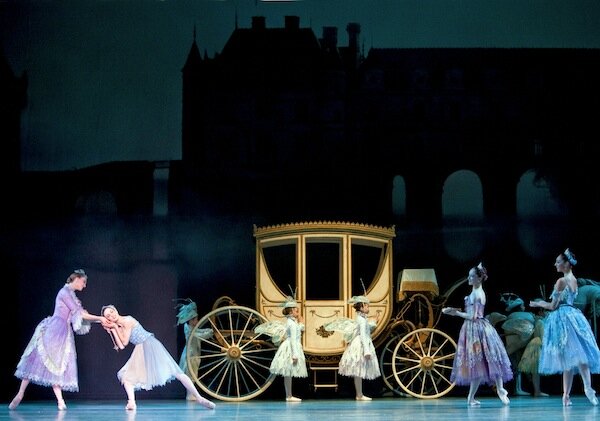 Pacific Northwest Ballet corps de ballet dancer Kylee Kitchens as Fairy Godmother and soloist Rachel Foster as Cinderella with PNB School students and Company dancers in Kent Stowell’s "Cinderella" (Photo © Angela Sterling)
Pacific Northwest Ballet corps de ballet dancer Kylee Kitchens as Fairy Godmother and soloist Rachel Foster as Cinderella with PNB School students and Company dancers in Kent Stowell’s "Cinderella" (Photo © Angela Sterling)
This is a ballet that draws adorable little moppets like nothing else. They may fade a little at an evening performance; I saw a few fathers heading out at second intermission with daughters deep in slumber over their shoulders. That's all right: They've seen the stepsisters carrying on, the carriage trip and ball's extravagant romance, by then.
Pacific Northwest Ballet's Cinderella (at McCaw Hall through Feb. 13) is like a hyper-elaborate dessert menu option, just slightly piquant, unfailing sweet, and technically impressive. Now, as a child-free curmudgeon, I don't really go in for this sort of thing, but it is actually a remarkable production. The combination of Martin Pakledinaz's glittering array of form-fitting, flowing, and wedding-cake-fantasy costumes, Tony Straiges' cinematic projections and gauzy scrims (plus the fairytale carriage), and Randall G. Chiarelli's warm-glow lighting pile on top of each other like layers of fruit and icing on a Prokofiev and Stowell cake.
If there's a weakness to Kent Stowell's on-the-bright-side telling, it's that nothing all that bad happens, people just like to dance. Cinderella has fond, beyond-a-scrim memories of her parents in former days to compensate for being ordered around like a servant, and she's so good-natured that even being skipped over for the ball doesn't really get her down. She's still playful with her stepsisters.
The dramatic stakes are just not very high--and as if to get downplay that by searching out extremes, Stowell's choreography gives some scene-stealing dancing to characters who have little dramatic reason for being (coughs, looks at jester), and explodes your head with the cute of little bug/fairy kids and clock/pumpkin children dancing like the most sincere pumpkin patch ever come to life. The little ones have real choreography to perform, and their applause is well-earned.
Stowell has also cut-and-pasted from Prokofiev's other works as he saw fit to fill out the original ballet score; it's a little disconcerting to hear a little Eugene Onegin, a little Lermontov, a little A Summer's Day Suite, a little gavotte, a little Tale of the Stone Flower, a little Love for Three Oranges. It begins to feel like someone left the orchestra on shuffle. That said, the PNB orchestra under Emil de Cou, sounded terrific, full of verve and brio, and wonderfully articulate even in gentle, dreamy passages. De Cou got bigger and bigger applause each time he returned to the podium.
Pacific Northwest Ballet company dancers in the ball scene from Kent Stowell’s "Cinderella" (Photo © Angela Sterling)
As it typical, you get different cast arrangements on different nights. Saturday night, Carla Körbes gave us a youthful, high-spirited, even mischievous Cinderella--shoulders straight, feet cheerfully pointing. As her stepsisters (Jessika Anspach and Abby Relic, both adept at their slapstick, nose-in-the-air sibling feuding and pratfalls) prepare for the ball--Kiyon Gaines appeared as the Dress Maker, Andrew Bartee subbed in for Jonathan Porretta as the snooty-but-overmatched Dancing Master--Körbes' impish Cinderella was everywhere in the background, trying out steps and helping with fittings.
Ariana Lallone was the imperious, ramrod-backed stepmother, all right-angled direction. (Olivier Wevers, as the put-upon father, doesn't have much to do until later, when he proudly presents his daughter to the Prince.) Laura Gilbreath was both the godmother and "memory-mother" that Cinderella recalls in quiet moments--in Stowell's version, good memories (mom and dad hugging) are the ground from which grows the magic of our later lives. It's the pumpkin of reverie that becomes the fabulous coach. Gilbreath had what amounts to a prop dance, in that she has to keep her wand moving from hand to hand during her dance with Cinderella.
Each act has a small sub-dance that is largely dance for dance's sake; you get Spring (Chalnessa Eames), Summer (Lesley Rauch), Autumn (Lindsi Dec), and Winter (the tremendously-named Kylee Kitchens), all in Pakledinaz finery. You get a Theatre of Marvels with an evil sprite (Jerome Tisserand, in a costume looking like Venom met Cats, but he carried it off), a good fairy (Laura Gilbreath), and Harlequin (Lucien Postlewaite) and Columbine (Lesley Rauch). And then Spring, Summer, Autumn, and Winter return to pretty up the third act.
The jester (I believe it was James Moore stepping in for Porretta) does have a role to play--he's blocker for the stepsisters at the ball--but that doesn't really explain the leaps, spins, and turns requiring such power and timing. You're not liable to complain about it, although it's bemusing.
What you have really come to see is that moment that the Prince (Batkhurel Bold) lifts Körbes' Cinderella aloft as they first meet--it's a power move, wrenching her out of the crowd and holding her up above. Körbes' back is arched so that she is Bold's sky. They will have a pas de deux at the ball that is storybook sweet--if light on heat--with Körbes, held by Bold, floating across the stage, her foot dragging lightly behind. But it's that moment of discovery that Stowell gets so right, I think. It's le geste juste.
 Subscribe to our Front Page Stories
Subscribe to our Front Page Stories
![]() Subscribe to all SunBreak Stories
Subscribe to all SunBreak Stories

Most Recent Comments